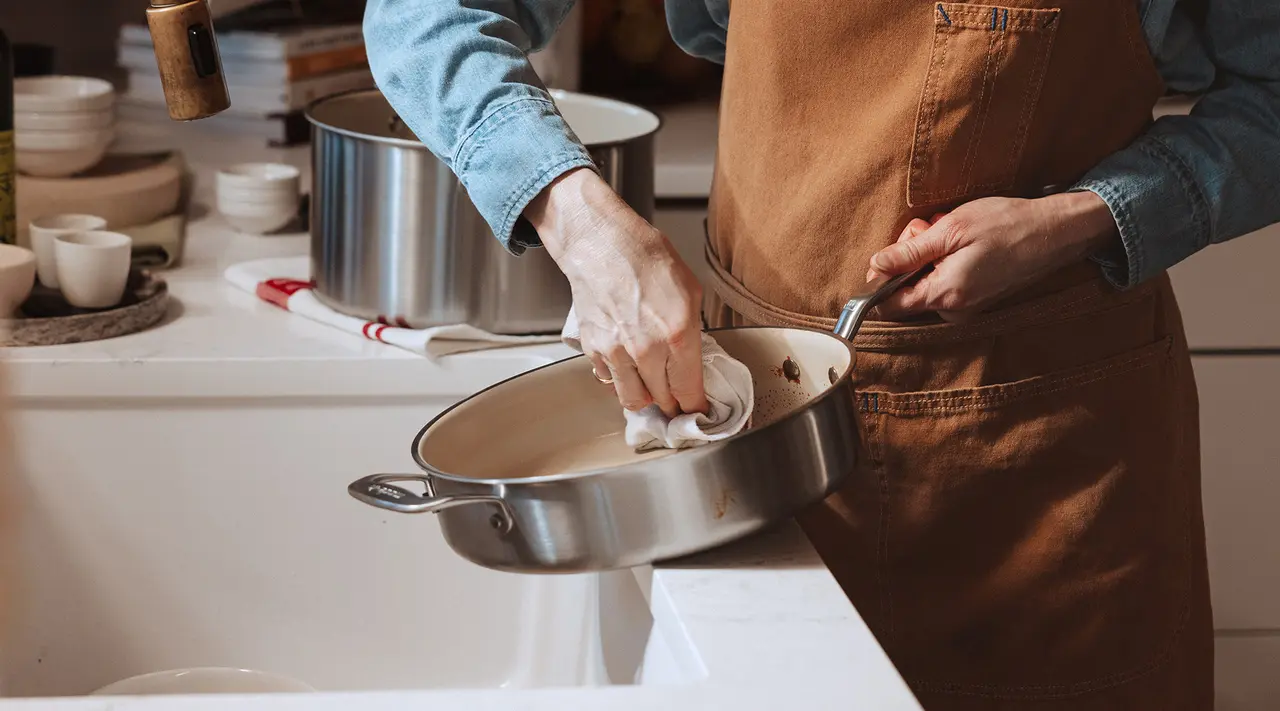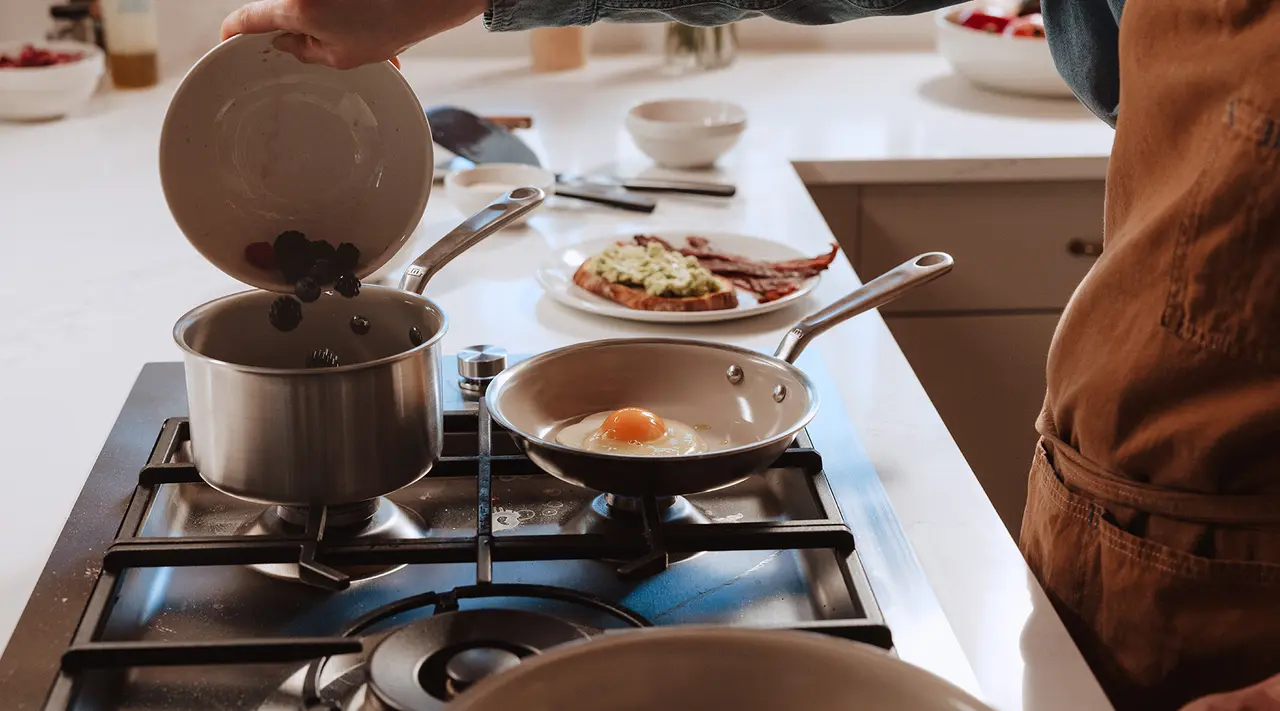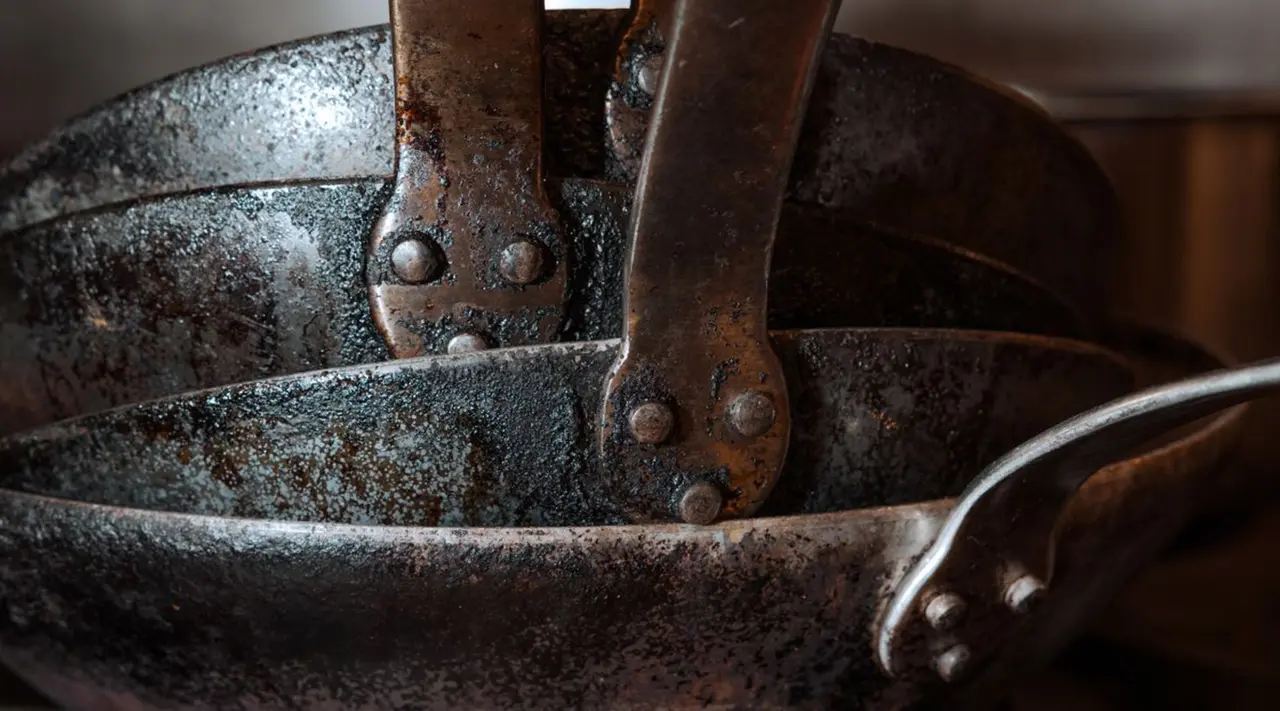There’s nothing quite like a brand new ceramic pan, with its glossy, eggshell-colored surface just waiting to fry up perfect pancakes, eggs, and crispy bacon. That said, after a few uses you may notice your pan starting to look a little less immaculate than it did fresh out of the box. From tea-colored stains to splotches of burnt-on oil, a little discoloration is inevitable—though it doesn’t have to be permanent.
Here’s how to tackle staining on your ceramic and leave your pan looking good as new.
What Causes Ceramic Pans to Stain?

Ceramic pans aren’t significantly more prone to staining than other kinds of cookware. Staining and discoloration are completely normal, particularly if you actually use your cookware on a daily basis (which we very much endorse).
With that being said, ceramic pots and pans tend to show staining and discoloration more easily than other materials due to the lighter color of the coating. And while these stains don’t typically impede the cooking process, they can cause some distress—especially if you’re someone who gets hung up on aesthetics.
Heat and Residue
We always recommend using low-to-moderate heat with ceramic cookware, and keeping oven usage to a minimum. Aside from discoloring and gradually degrading the non stick surface, high heat can also cause food and oil to stick and burn.
Improper Cleaning
Leaving a dirty pan to sit out for several hours or overnight allows food residue or burnt-on oil to further set, making it harder to remove. Always clean ceramic cookware immediately after each use, and make sure to clean your pan gently (but thoroughly) with dish soap, water, and sponge, or by using one of the methods listed in the following section.
Use of Certain Ingredients
Highly-pigmented foods like beets, red wine, and turmeric can also cause stains or discoloration. Either avoid these ingredients entirely when cooking with ceramic cookware, or be sure to clean your pan immediately once it’s cooled down.
How to Remove Stains from Ceramic Cookware

Again, you can avoid stained or discolored cookware by washing thoroughly after each use and keeping the heat on low or medium. If you do wind up with stubborn stains on your CeramiClad™ Non Stick Cookware, however, here's a safe and effective way to remove them.
You’ll need dish soap (for the initial rinse), baking soda, white vinegar, a dish sponge, and warm water. Here’s the step-by-step process.
- Allow the pan to cool completely, then wash with warm water and dish soap to remove residual amounts of food or oil.
- Mix together a paste of baking soda and vinegar in a 1:1 ratio—2 tablespoons of each should do the trick.
- Coat the inside of your pan with the baking soda-vinegar paste, then use your sponge to gently scrub the entire surface. If the stain is still there, proceed to the next step.
- Add a few tablespoons of water to the pan and bring to a simmer over medium-low heat. Use a silicone or wood spatula or spoon to stir the mixture until the baking soda has fully dissolved, gently scraping at the stained areas. Simmer until the residue starts to loosen.
- Allow the pan to cool completely before dumping out the remaining liquid, then rinse the pan out with warm water. Give it a final clean with water and dish soap before drying.
Ceramic Cookware Maintenance Tips

Aside from staining, here's how to keep your CeramiClad™ in top-tier condition.
- Keep sharp-edged metal utensils far away from ceramic and stick to non-abrasive materials like silicone, wood, and nylon;
- Cook over low or moderate heat, and limit oven usage (even if your pan is oven safe);
- Store pans carefully (ceramic or otherwise), whether by stacking (making sure to lay a Pan Protector, dish towel, or trivet inside each pan), hanging, or by placing in a single layer in your cupboard or on your stovetop;
- Avoid aerosol-based cooking sprays, as these create a buildup that can be difficult to remove without compromising the non stick surface of your pan.
Ready to Cook?
Fear of staining shouldn’t keep you from using your ceramic cookware—especially now that you know how to get rid of it. And that’s a good thing, because our CeramiClad™ Non Stick deserves a place in the spotlight (or, you know, on your stovetop).































